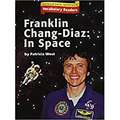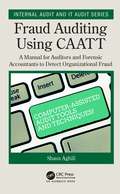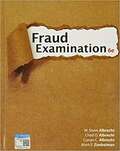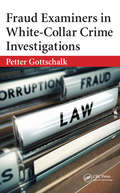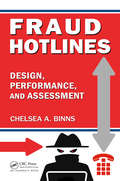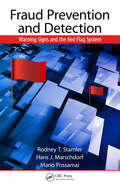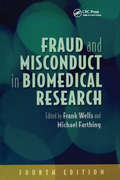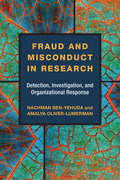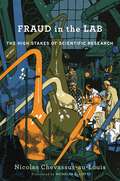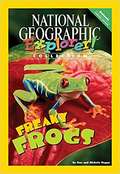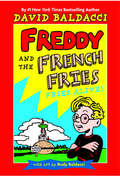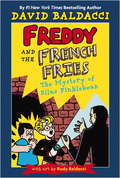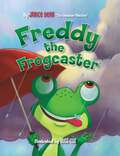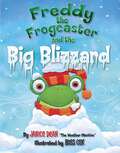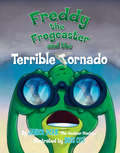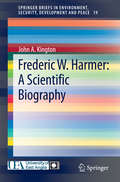- Table View
- List View
Frankie Sparks and the Big Sled Challenge (Frankie Sparks, Third-Grade Inventor #3)
by Megan Frazer BlakemoreFrankie Sparks uses her inventing skills to build the best sled ever in this third chapter book in the STEM inspired Frankie Sparks, Third-Grade Inventor series.Frankie Sparks can&’t wait to enter the town-wide sled design contest. With the help of a team, she must design and build a sled using only cardboard and duct tape. And there are PRIZES! Each team in the contest will be judged on: 1. Best looking sled. 2. Fastest sled. 3. Most team spirit. Even though Frankie might know a lot about building a sled, it turns out she still has a lot to learn about building a team. With lots of twists, turns, and big bumps along the way, can Frankie and her fellow super-sled designers create a dream machine—and a dream team?
Frankie Sparks and the Class Pet (Frankie Sparks, Third-Grade Inventor #1)
by Megan Frazer BlakemoreIvy and Bean meets Aliens in my Pocket in this start to a brand-new chapter book series about Frankie Sparks, a third grader who uses her love for science and math to help her solve problems she comes across in her daily life.The best thing EVER is happening in Frankie Sparks’s third grade class: They are getting a class pet! Their teacher, Miss Cupid, tells them they will vote on their pet, but it has to meet some “parameters.” Their pet must: 1. Fit in aquarium. 2. Cost less than $50. 3. Be easily portable. 4. Be able to be left alone for the weekend. Frankie thinks that a rat—just like the rats in her beloved Aunt Gina’s lab—would be the perfect fit. But her best friend, Maya, doesn’t think a rat would be great at all. They are kind of gross and not as cool as a hermit crab, which is Maya’s top choice. Using her special workshop, can Frankie find a way to convince her teacher and her best friend that Team Rat is the way to go?
Frankie Sparks and the Lucky Charm (Frankie Sparks, Third-Grade Inventor #4)
by Megan Frazer BlakemoreFrankie Sparks uses her inventing skills to trap a leprechaun in this fourth chapter book in the STEM inspired Frankie Sparks, Third-Grade Inventor series.It&’s springtime in Ms. Cupid&’s class, and the entire class is excited to build their very own leprechaun traps. Maybe, if they catch one, they will all get the gift of good luck! And after a few magical clues, it looks like there might be a leprechaun on the loose in Frankie Sparks&’s house! Her best friend, Maya, is convinced the leprechaun exists, but Frankie has her doubts—especially when it feels like every trap she designs fails! Will Frankie and Maya find their lucky charm, or figure out how to create some luck all on their own?
Frankie Sparks and the Talent Show Trick (Frankie Sparks, Third-Grade Inventor #2)
by Megan Frazer BlakemoreFrankie Sparks uses her inventing skills to help her friend overcome stage fright in this second chapter book in the STEM inspired Frankie Sparks, Third-Grade Inventor series.It’s time for the annual school talent show, and Frankie is excited to audition with her magic act! She wants to be just like her idol, Adelaide Herrmann, Queen of Magic. But on the day of the audition, Frankie’s best friend and Magician’s Assistant, Maya, gets a big, scary case of stage fright! How can Maya be Frankie’s helper on stage if she can’t bring herself to speak in front of their audience? It’s up to Frankie Sparks to invent just the perfect thing to help her best friend cope with the spotlight!
Franklin Chang-Diaz: In Space (Houghton Mifflin Harcourt Vocabulary Readers #Leveled Reader: Level: 4, Theme: 1.2)
by Patricia WestBrief biography of Franklin Chang-Diaz, an astronaut.
Frantastic Voyage (Franny K. Stein, Mad Scientist #5)
by Jim BentonGoosebumps and Bill Nye the Science Guy fans, meet Franny!Franny&’s faithful Lab assistant, Igor, has swallowed a doomsday device that is ready to go off at any moment! For a regular scientist, it might seem like there&’s only one way to get the device out—um...make that two ways. But Franny K. Stein is no ordinary scientist, so she concocts her own way to get the device back and save her friend. With her miniaturization machine, Franny shrinks herself to the size of a pin and goes on a field trip like no other...through the body of a ticking time-dog! Fasten your seat belts, it&’s going to be a bumpy ride!
Fraud Auditing Using CAATT: A Manual for Auditors and Forensic Accountants to Detect Organizational Fraud (Internal Audit and IT Audit)
by Shaun AghiliThis book discusses various common occupational and organizational fraud schemes, based on the Association of Certified Fraud Examiners (ACFE) fraud tree and assist fraud examiners and auditors in correctly choosing the appropriate audit tests to uncover such various fraud schemes. The book also includes information about audit test red flags to watch out for, a list of recommended controls to help prevent future fraud related incidents, as well as step-by-step demonstrations of a number of common audit tests using IDEA® as a CAATT tool.
Fraud Examination (Mindtap Course List)
by W. Steve Albrecht Chad O. Albrecht Conan C. Albrecht Mark F. ZimbelmanLearn to identify, detect, investigate and prevent financial fraud today with the latest edition of Albrecht/Albrecht/Albrecht/Zimbelman's FRAUD EXAMINATION, 6E. Develop fraud skills as you become a better interviewer, stronger and more skeptical document examiner, better technology user and more informed decision maker. Closely examine and gain a strong understanding of the types of fraud and nature of fraud investigation today with current business examples and numerous actual fraud cases, delivered first-hand from the authors' experience. FRAUD EXAMINATION presents today's most important fraud concepts with an emphasis on the growing areas of ebusiness and cyber fraud. Significant discussion familiarizes you with forensic analysis as well as legal options for victims of fraud. New discussion also highlights how experts use technology to accomplish fraud and detect fraud.
Fraud Examiners in White-Collar Crime Investigations
by Petter GottschalkIn Fraud Examiners in White-Collar Crime Investigations, Petter Gottschalk examines and evaluates the investigative processes used to combat white-collar crime. He also presents a general theory regarding the economic, organizational, and behavioral dimensions of its perpetrators.Pool Your Resources for a Successful InvestigationGottschalk emphasiz
Fraud Hotlines: Design, Performance, and Assessment
by Chelsea A. BinnsThis book provides a complete guide on fraud hotlines. It is designed to educate readers with respect to the history, purpose, operation, use and utility of fraud hotlines. It also equips readers with the knowledge to create, analyze and assess the performance of fraud hotlines.
Fraud Prevention and Detection: Warning Signs and the Red Flag System
by Mario Possamai Rodney T. Stamler Hans J. MarschdorfMost fraud cases could have been prevented or detected earlier if early warning signs had been taken seriously. This volume enables officers and directors to protect themselves and their entities against fraud by effectively detecting, analyzing, and acting before any damage can be done. Based on an empirically tested strategy, the book teaches readers how to find Red Flag indicators of fraud or suspicious transactions in financial statements, budgets, and contracts and know how to ensure that, once a Red Flag has been identified, appropriate action is taken.
Fraud and Misconduct in Biomedical Research, 4th edition
by Frank Wells Michael FarthingNow in its fourth edition, Fraud and Misconduct in Biomedical Research boasts an impressive list of contributors from around the globe and introduces a new focus for the book, transforming it from a series of monographs into a publication that will quickly become an essential textbook on all areas of research fraud and misconduct.Key features inclu
Fraud and Misconduct in Research: Detection, Investigation, and Organizational Response
by Nachman Ben-Yehuda Amalya Oliver-LumermanIn Fraud and Misconduct in Research, Nachman Ben-Yehuda and Amalya Oliver-Lumerman introduce the main characteristics of research misconduct, portray how the characteristics are distributed, and identify the elements of the organizational context and the practice of scientific research which enable or deter misconduct. Of the nearly 750 known cases between 1880 and 2010 which the authors examine, the overwhelming majority took place in funded research projects and involved falsification and fabrication, followed by misrepresentation and plagiarism. The incidents were often reported by the perpetrator’s colleagues or collaborators. If the accusations were confirmed, the organization usually punished the offender with temporary exclusion from academic activities and institutions launched organizational reforms, including new rules, the establishment of offices to deal with misconduct, and the creation of re-training and education programs for academic staff. Ben-Yehuda and Oliver-Lumerman suggest ways in which efforts to expose and prevent misconduct can further change the work of scientists, universities, and scientific research.
Fraud in the Lab: The High Stakes of Scientific Research
by Nicolas Chevassus-au-LouisFrom manipulated results and fake data to retouched illustrations and plagiarism, cases of scientific fraud have skyrocketed in the past two decades. In a damning exposé, Nicolas Chevassus-au-Louis details the circumstances enabling the decline in scientific standards and highlights efforts to curtail future misconduct.
Freaky Frogs, Pioneer Edition (National Geographic Explorer Collection)
by Dan Hogan Michele HoganNIMAC-sourced textbook
Fred Sanger Double Nobel Laureate
by George G. BrownleeConsidered 'the father of genomics', Fred Sanger (1918-2013) paved the way for the modern revolution in our understanding of biology. His pioneering methods for sequencing proteins, RNA and, eventually, DNA earned him two Nobel Prizes. He remains one of only four scientists (and the only British scientist) ever to have achieved that distinction. In this, the first full biography of Fred Sanger to be published, Brownlee traces Sanger's life from his birth in rural Gloucestershire to his retirement in 1983 from the Medical Research Council's Laboratory of Molecular Biology in Cambridge. Along the way, he highlights the remarkable extent of Sanger's scientific achievements and provides a real portrait of the modest man behind them. Including an extensive transcript of a rare interview of Sanger by the author, this biography also considers the wider legacy of Sanger's work, including his impact on the Human Genome Project and beyond.
Freddie Spector, Fact Collector: Space Cadet
by Ashleigh BartonDid you know that a bolt of lightning is five times hotter than the Sun? Or that slugs have four noses? How about that humans share 50 per cent of our DNA with bananas? Freddie Spector, the world's greatest fact collector, knows all these things and so much more.Freddie Spector loves collecting facts - about anything and everything. His latest obsession is space. It's all he talks about: stars, planets, galaxies, astronauts, space travel - and, of course UFOs and extraterrestrials. Freddie writes all his facts on sticky notes that his mum and big sister, Henrietta, keep finding in weird places - like in their sock drawers or their sandwiches.But whenever Freddie collects facts on a topic, his very active imagination always gets involved too. And, after noticing some very suspicious goings-on, Freddie realises it's up to him to discover the answer to a burning question: could aliens have landed in his neighbourhood?Fast-paced and funny, this series is all about an everyday eight-year-old boy whose love of facts and extraordinary imagination come together with unexpected and hilarious results.
Freddie and the French Fries #2: The Mystery of Silas Finklebean
by David BaldacciTHE FAB FRIES RETURN FOR ANOTHER WACKY CAPER--THROUGH TIME AND SPACE! The Gang: Freddy T. Funkhouser, science whiz kid; Howie Kapowie, his cheese-cube-chowing sidekick; and Freddy's most incredible inventions: five living, breathing French fries by day, superpowered kick-butt spuds by night! The Plan: Use the secret notes of mysterious missing inventor Silas Finklebean to construct a time travel machine (from a pile of junk) that sweeps the annual science competition and creams Pookesville's baddest bully, Adam Spanker, once and for all. The Big questions: Will Freddy's time-warp team beat the clock before Adam's exploding volcano buries the Funkhouser family restaurant, the Burger Castle, in goopy purple lava? And can they finally crack the case of the long-lost Silas Finklebean? Bestselling author David Baldacci cooks up another scrumptious adventure, this time stirring in a dash of spooky mystery and zany science fiction, and topping it with a big helping of laughs!
Freddy and the French Fries #1: Fries Alive! (Freddy and the French Fries #1)
by David Baldacci Arudy BaldacciA master crafter of thrills, bestselling novelist David Baldacci shows his tremendous talent for side-splitting storytelling in this hilarious adventure about fame, friends, and family. Here is the story where readers first met Theodore, Wally, Curly, Ziggy, Si, and Meese (French fries so lovable you won't want to eat them!). But shoestring, waffle, wedge, curly, and crinkle-cut potatoes were never more irresistible than in this zany adventure about five giant fries that come to life--well, six if you count heads. It all begins when Freddy Funkhauser, an offbeat nine-year-old with a knack for science, embarks on an ambitious plan to win new customers for the family business, The Burger Castle. But when his secret invention ends up working better than he'd ever dreamed, his plans go wildly awry as his kooky companions wreak havoc in every corner of Freddy's world!
Freddy and the French Fries #2: The Mystery of Silas Finklebean (Freddy and the French Fries #2)
by David BaldacciIn this sequel to "Fries Alive!," Freddy Funkhauser discovers the lab of long-lost scientist Silas Finklebean, along with instructions on how to build a time machine. With Finklebean's help, Freddie is determined to prove himself to bully Adam Spanker.
Freddy the Frogcaster
by Janice DeanFreddy the Frog loves learning about the weather, and he's known for having the best predictions in town. But what happens when the town picnic is almost ruined by a storm that catches the local frogcaster by surprise? Freddie has to step in to save the day! Well-known Fox News broadcast meteorologist Janice Dean pens this exciting and hilarious tale about an aspiring weathercaster who can't keep his eyes off the sky. Children and adults will love the charming frog world Freddy lives in, and the fun science lessons he shares, with an activities section in the back
Freddy the Frogcaster and the Big Blizzard
by Janice DeanFreddy the Frog loves learning about the weather, and he’s known for having the best predictions in town. But what happens when a blizzard rolls in?
Freddy the Frogcaster and the Terrible Tornado
by Janice DeanGet ready for a whirlwind of adventure with Freddy the Frogcaster when a famous storm chaser visits Lilypad! In her fourth book, well-known meteorologist Janice Dean tackles some scary weather. Freddy the Frogcaster is faced with one of the most ferocious and devastating kinds of weather: the tornado. Young readers will learn all about how big storms occur and produce some of nature's most destructive weather. Chock-full of storm science lessons in the back, children and adults alike will learn valuable life-saving information. As Freddy reminds us, please be prepared and know what to do and where to go when the next bad storm comes your way! <p><p> <i>Advisory: Bookshare has learned that this book offers only partial accessibility. We have kept it in the collection because it is useful for some of our members. To explore further access options with us, please contact us through the Book Quality link on the right sidebar. Benetech is actively working on projects to improve accessibility issues such as these. </i>
Frederic W. Harmer: A Scientific Biography
by John A. KingtonComprising the first definitive account of the geological and palaeometeorological studies made by the British geologist, Frederic W. Harmer (1835-1924) this book contributes a previously missing chapter to the history of science. The main objective of the author is to ensure that the scientific work of Harmer, which unfortunately has been widely neglected or forgotten, becomes more generally known and acknowledged. The balance of this deficiency will be redressed by bringing to light in this volume his contributions to the history of science to an audience of academic and lay readers of the current literature.
Free Agents: How Evolution Gave Us Free Will
by Kevin J. MitchellAn evolutionary case for the existence of free willScientists are learning more and more about how brain activity controls behavior and how neural circuits weigh alternatives and initiate actions. As we probe ever deeper into the mechanics of decision making, many conclude that agency—or free will—is an illusion. In Free Agents, leading neuroscientist Kevin Mitchell presents a wealth of evidence to the contrary, arguing that we are not mere machines responding to physical forces but agents acting with purpose.Traversing billions of years of evolution, Mitchell tells the remarkable story of how living beings capable of choice arose from lifeless matter. He explains how the emergence of nervous systems provided a means to learn about the world, granting sentient animals the capacity to model, predict, and simulate. Mitchell reveals how these faculties reached their peak in humans with our abilities to imagine and to be introspective, to reason in the moment, and to shape our possible futures through the exercise of our individual agency. Mitchell&’s argument has important implications—for how we understand decision making, for how our individual agency can be enhanced or infringed, for how we think about collective agency in the face of global crises, and for how we consider the limitations and future of artificial intelligence.An astonishing journey of discovery, Free Agents offers a new framework for understanding how, across a billion years of Earth history, life evolved the power to choose, and why it matters.




